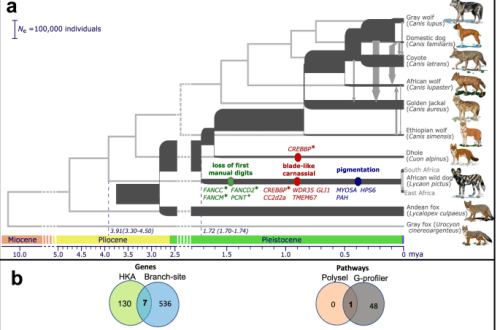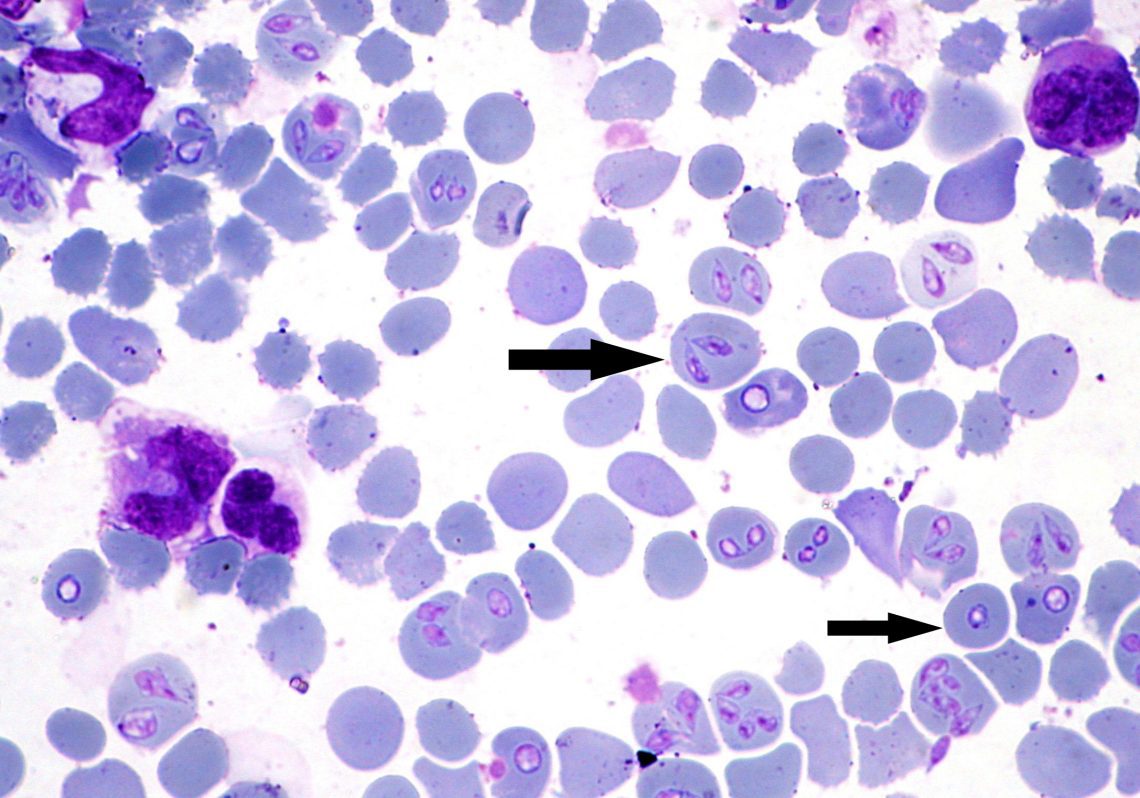
Piroplasmosis in dogs
Contents
- Features of the pathogen
- When and where does a dog become infected with piroplasmosis
- How long is the incubation period
- Symptoms of piroplasmosis in dogs
- Diagnostics
- How is piroplasmosis treated?
- How to care for a pet
- What can you feed your dog
- Consequences of piroplasmosis
- Forecast and prevention of piroplasmosis
Features of the pathogen

Ixodid ticks – causative agents of piroplasmosis
During its life cycle, the babesia must change two owners. The main host is the ixodid tick, and the dog is an intermediate one, in the body of which the asexual reproduction of the parasite occurs by dividing the original cell into two daughter cells.
In general terms, parasites, when bitten by an infected tick of an animal, enter the bloodstream, enter the red blood cells, where they divide. The erythrocyte disintegrates, the daughter cells of the parasite again enter the bloodstream and invade the red blood cells.
When an infected dog is bitten by an ordinary tick, the protozoan enters its intestines along with infected erythrocytes. After a series of transitional stages, Babesia cells turn into gametes, which, merging, give rise to a zygote (sexual reproduction). After some time, the zygote becomes a source of thousands of microscopic single-celled parasites that become the cause of infection with piroplasmosis in the next dog.
When and where does a dog become infected with piroplasmosis
Basically, dogs become infected with piroplasmosis in spring and autumn, when the activity of ixodid ticks is highest. However, there is a possibility of infection in summer (under certain weather conditions) and winter (in regions with a warm climate or during thaws). Most often, the disease affects animals in the spring, as ticks “wake up” from hibernation and are very toxic.
In recent years, there has been a massive defeat of dogs, not only living near forests or fields, but also in cities. A decrease in resistance to piroplasmosis in outbred pets is also noted. Previously, predominantly purebred dogs fell ill, which is explained by weaker immunity, but today a large number of cases of infection of crossbreeds and mongrels are recorded.
A pet of any age can get sick with piroplasmosis. The most susceptible are young and old dogs. It is believed that animals of the middle age category tolerate the disease more easily, especially if similar episodes have already occurred. However, in this case, the pet may die, so at the first symptoms of piroplasmosis, you should immediately contact the clinic. The disease can proceed in an erased form, not as clearly as in the case of primary infection, it can become chronic, which is just as dangerous as in the case of an acute course.
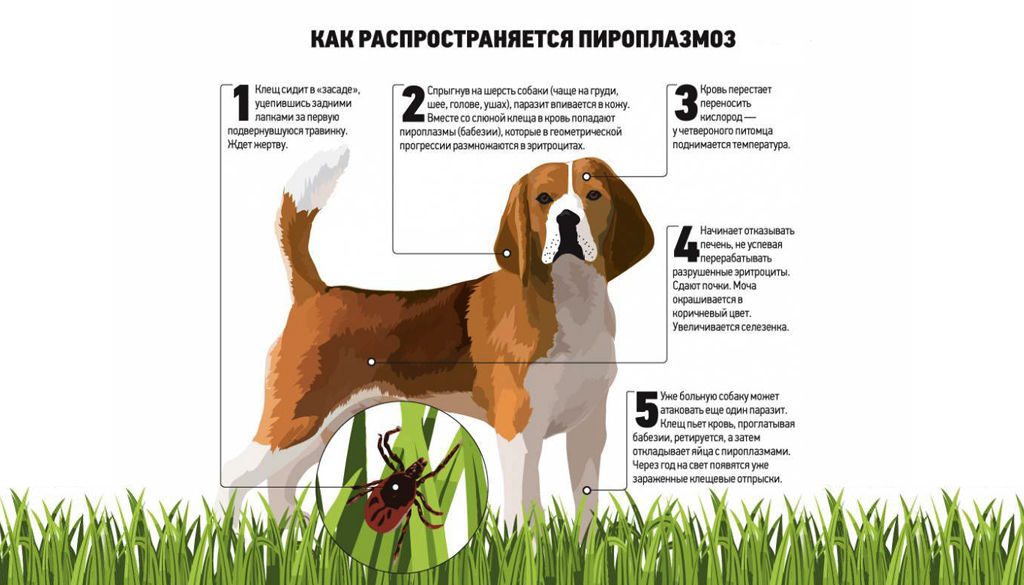
How long is the incubation period
The incubation period for piroplasmosis in dogs lasts from two days to three weeks. It depends on a number of factors:
- the state of the immune system, general well-being;
- age features;
- familiality;
- the presence of episodes of the disease in the past;
- whether prophylactic treatment of the dog with anti-tick drugs was carried out.
Symptoms of piroplasmosis in dogs
Reproducing in the bloodstream of a dog and destroying red blood cells, babesia lead to severe intoxication of the body, disruption of the heart, nervous system, liver, and kidneys.
The clinical picture also depends on the characteristics of the dog’s body and on the form of development of the disease. Acute piroplasmosis is characterized by the following symptoms:
- apathy;
- an increase in body temperature – sometimes to high, life-threatening values;
- shortness of breath associated with oxygen deficiency due to the destruction of hemoglobin;
- change in the color of urine – first dark, then with a red or burgundy tint;
- yellowing of the sclera of the eyes, oral mucosa;
- refusal not only from food, but also from drinking;
- weakening of the limbs, difficulty with movement.
Lack of treatment within 2-4 days will lead to a disorder of the respiratory and cardiac systems, dehydration, paralysis, and death of the animal. Under no circumstances will the dog’s body be able to cope with piroplasmosis on its own!
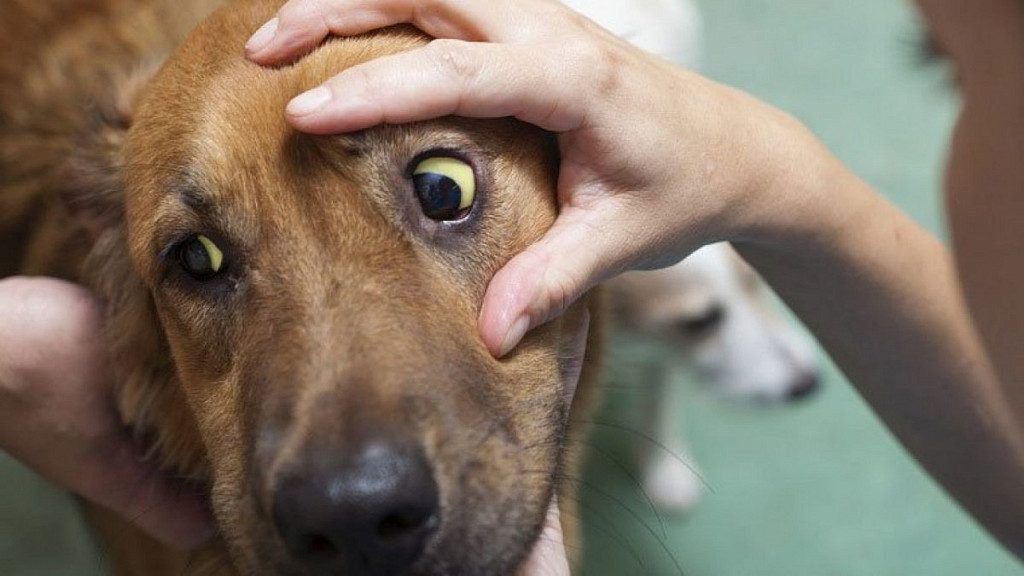
Yellowing of the sclera of the eyes is one of the symptoms of piroplasmosis
If the immunity is strong, the pet suffered piroplasmosis earlier or in the case of a chronic course of the pathology, the symptoms may be as follows:
- lethargy;
- refusal of food;
- increased body temperature;
- muscle weakness;
- breaking stool.
By the way, if the disease has a chronic course, then any negative impact, for example, nervous stress or surgery, can provoke an exacerbation.
Diagnostics
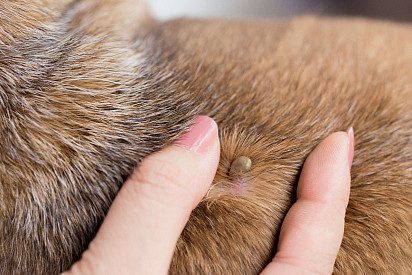
What does a tick bite a dog look like?
Usually, the owner’s story and examination of the dog is enough to make a diagnosis of piroplasmosis, especially if a tick has been found. But since not all symptoms may appear, for example, at the onset of the disease or during its chronic course, and not fully, in order to exclude pathologies with similar symptoms, diagnostics are carried out.
To confirm the diagnosis, laboratory tests of blood and urine are performed. A clinical blood test shows the level of red blood cells, white blood cells, hemoglobin. Biochemical research provides information about the presence of inflammatory processes in the body. With the help of microscopy, the doctor can establish the presence of the causative agent of piroplasmosis in the blood. Urinalysis, in which hemoglobin is detected, indicates the ongoing destruction of red blood cells.
How is piroplasmosis treated?
First of all, the veterinarian will make injections of drugs of the following groups:
- antiprotozoal – destroys the pathogen;
- glucocorticosteroid – relieves manifestations of allergies, inhibits the development of autoimmune processes;
- hepatoprotector – to maintain the liver, prevent its damage;
- antipyretic – at high temperature.
If the dog’s condition is very serious, she does not walk, there are symptoms of dehydration, muscle cramps and other disorders, the doctor will prescribe an intravenous administration of a solution of glucose, sodium chloride, Ringer. Treatment is aimed at restoring kidney function, detoxifying the body. Also shown drugs to normalize the functions of the heart, lungs, immune system. Vitamin complexes are often prescribed.
If necessary, they will prescribe plasmapheresis – cleaning the blood of toxic substances by filtering it. However, this procedure is not done in all clinics.
Piroplasmosis under the microscope
How to care for a pet
If the doctor has prescribed injections or droppers for the dog, and you do not know how to do them, agree in advance on the possibility of a specialist coming to the house. Otherwise, you will need to visit the clinic daily. In severe cases, it is advisable to place the pet in a hospital.
At home, it is recommended to limit the physical activity of the dog. You need to take the animal for a walk more often than usual, but reduce the duration of exposure to air to 10-15 minutes. You should also avoid any contact with other dogs (even domestic ones): a weakened immune system is unable to resist the slightest infection.
During the treatment period, you need to be extremely attentive to the dog, since the return of former activity and appetite can be deceptive. It happens that after a visible improvement, the animal’s condition deteriorates sharply, so sometimes piroplasmosis therapy can be delayed up to six months.
What can you feed your dog
Until recovery, the pet must be provided with a therapeutic diet. Its goal is to reduce the load on the liver and intestines, promote the rapid elimination of toxins, restore damaged tissues, and strengthen the immune system. For this you need:
- feed your pet often, but little by little;
- to increase the level of hemoglobin, introduce red meat, offal into the diet;
- for animals that eat industrial feed, choose a line of medicinal products with a low calorie content. If the food is dry, pre-soak it;
- give food at room temperature;
- add fresh herbs and vegetables to food. If the pet refuses to eat them, then the vegetables should be passed through a meat grinder, chopped in a blender or rubbed on a fine grater, and then mixed with the meat component.
If the dog had diarrhea during the illness, you need to restore the intestinal microflora. For this, it is useful to include fermented milk products, special pharmacological preparations in the diet. If kidney function is impaired, the protein content in the pet’s food should be reduced or eliminated altogether. In general, the composition and details of the diet are discussed with the veterinarian, based on laboratory data.
Consequences of piroplasmosis
Piroplasmosis can adversely affect the organs of many systems: excretory, digestive, cardiovascular, and so on. In addition to the pathogen, the drugs themselves can also have a negative effect on the body, since the damaged liver is not able to perform its detoxifying function.
A dog after piroplasmosis can acquire the following complications:
- heart failure;
- toxic hepatitis;
- pancreatitis;
- tendency to allergies;
- kidney failure;
- anemia.
If hypoxia was strongly pronounced during the illness, damage to the nervous system and brain is possible.
Piroplasmosis in pregnant dogs can lead to intrauterine death of offspring or the birth of puppies with developmental anomalies. During lactation, puppies should be isolated from an infected mother and transferred to artificial feeding.
Forecast and prevention of piroplasmosis
The prognosis of the disease depends on the timeliness of contacting a specialist. At an early stage – before signs of dehydration and hypoxia – veterinary care increases the likelihood of survival up to 95%. The later the owner of the dog turns to the clinic, the more the organs of the animal will be damaged, and the lower the percentage of survival.
Prevention of piroplasmosis consists only in treating the pet with anti-tick drugs and carefully examining it after each walk during the period of tick activity. Among the drugs can be noted drops for external application, aerosols, tablets for internal use.
- Drops. They are applied to the withers and / or along the entire length of the spine (on the skin and coat) at certain intervals. The drug does not have a systemic effect, that is, it does not penetrate the dog’s blood, but accumulates in the glands, hair follicles and epidermis. You need to repeat the treatment every 1-1,5 months. Frequent washing reduces the effectiveness of the product.
- Tablets. They are considered a fairly effective remedy for ticks, but they do not provide 100% protection. The duration of action is about 3 months. The active ingredient penetrates into the blood.
- Aerosol (spray). It has a deterrent effect on ticks. Washing a pet reduces the effectiveness to zero. Without bathing, the duration of protection is no more than 30 days.
- Collar. Impregnated with anti-mite compound. Among other means, it is considered the most effective, since the protective properties persist for six months. However, it also has a negative effect on the animal’s body, causing allergic reactions, local hair loss.
It must be borne in mind that the listed funds, without exception, have a high toxicity. Pets prone to allergies should use them with caution. It is better to give preference to plant-based sprays, but the treatment will have to be carried out often. If the pet’s coat and skin are treated, the tick will paralyze before it bites through the epidermis.
Inspection is carried out, first of all, in the armpits, groin, ears, tail, sternum. When a tick simply crawls over a dog’s coat or skin, it cannot infect it. The causative agent in an infectious form is located in the salivary glands of the tick, and until it sticks, infection will not occur.
It is important to remember that dogs do not develop immunity after piroplasmosis! There is also no vaccine for the disease. Moreover, the absence of a tick on the body of an animal is not an indication of the absence of a bite. The tick can bite and fall off after a few minutes.
The slightest changes in well-being should be the reason for contacting a specialist, because the pet’s health is only in the hands of the owner.





